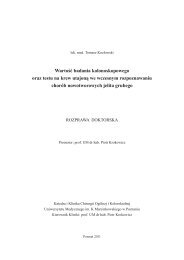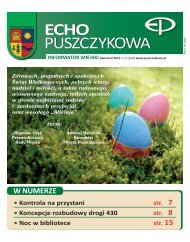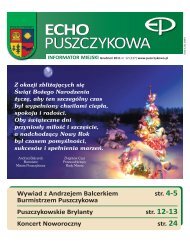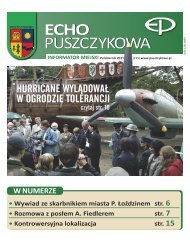MILITARY PHARMACY AND MEDICINE
MILITARY PHARMACY AND MEDICINE
MILITARY PHARMACY AND MEDICINE
You also want an ePaper? Increase the reach of your titles
YUMPU automatically turns print PDFs into web optimized ePapers that Google loves.
© Military Pharmacy and Medicine • 2012 • 4 • 85 – 86Magdalena Cybulska at al.: Autopsy marks on anthropological material …the skulls (removed calvaria), ribs, clavicles andvertebral bodies.Bone marks indicate that autopsies were performedin order to establish the cause of death,but also served the purpose of educating futuredoctors. For example, limb amputations werepracticed on cadavers. Autopsies were conductedon female, male cadavers, but also onbodies of children and fetuses. There is a lot ofanthropological material from 18 th and 19 th centuryLondon showing that autopsies were frequentatthat time [25].Italian anatomist, Giovanni Battista Morgagni(1682-1771) thought that it is a duty of a doctorto perform post-mortem examinations of hispatients. He supposed that disease is localized ina particular organ [4].Great development of anatomical studiesoccurred from the second half of 20 th century,as indicated by anthropological excavation dataas well as written sources. This fact is related toprogress in the field of surgery and anatomopathologyitself. General anesthesia and introductionof antiseptics and aseptics to operatingrooms, improved hemostasis led the surgeons tobroaden the range of procedures and advancedeeper into human tissues. The significance ofanatomopathological studies in clinical medicinewas also emphasized. Doctors linked diseasesymptoms they saw in their patients withanatomopathological picture seen on an autopsytable. Therefore, post-mortem examinationswere supposed to be a way to explain pathologicalchanges. Karl von Rokitansky (1804-1878), aCzech who co-created the new Viennese schoolalso known as anatomopathology school in thehistory of medicine, had great contributions topathological anatomy [4, 26].Modern medical textbooks pertaining to theissue of post-mortem examinations also describecranial opening. Soft tissues should be first separated:skin, dense connective tissue layer, tendinouscap of the epicranial muscle, loose connectivetissue layer and periosteum of calvaria.Incision runs about 2.5 cm above the superiormargin of the orbit and posteriorly about 1 cmabove the external occipital tuberosity. Externallamina is cut with a saw and separated fromthe diploe using a chisel. External and internalhttp://military.isl-journals.comlamina can be also simultaneously cut with anoscillation saw [27]. Therefore, in the medievaltimes soft tissues also had to be removed beforeuncovering the bone. Saws and chisels were usedfor cutting bones.Autopsy techniques evolved together with theprogress of medical sciences. Particularly the 19 thcentury is related to development of post-mortemexaminations. During that time, Rudolf Virchow(1821-1902) — the creator of cellular pathology— and previously mentioned Karl Rokitansky(1804-1878) exerted great influence on theexamination technique [28].Medical historians also use art for their studies.In the 17 th century, many painters depicteddoctors performing autopsies. The painting byRembrandt “The Anatomy Lesson of Dr JoanDeyman” (1656) depicts a medic performingan autopsy of human brain using a scalpel. Anassistant standing to the right of doctor JoanDeyman holds calvaria, removed (sawn-off) inorder to uncover the brain. We find signs of suchprocedures in anthropological material. Unfortunately,only the middle portion of the paintingremained, while three quarters of it was burnt inthe anatomical theater fire [29, 30].Osteologic data suggest that autopsies were commencedin Poland during late Middle Ages. Theywere not public. Material acquired from historicalcemeteries indicates (we analyzed six archeologicalsites for the purpose of this publication)that sections were carried out earlier than suggestedby written sources. However, developmentof anatomical studies in Poland as well asin other European countries falls on 18 th and 19 thcentury. Possibly, cadavers for the autopsy camefrom cemeteries by the hospitals and churches.First autopsies resulted from scientists’ curiosity,need to search for the cause of the disease anddeath. Didactics played a smaller role.At the turn of Middle Ages and renaissance aswell as in renaissance, people began to realizethe necessity of performing anatomical studiesfor educational purposes. Until 18 th century,public autopsies excited emotions from bothmunicipal and church officials and they usuallyinvolved convicts’ bodies. Cadavers for anatomopathologicautopsies could come from warfare,they could belong to the homeless, prisoners85
















